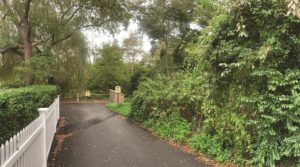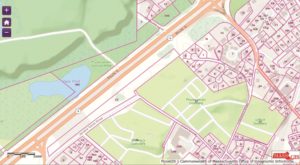PROVINCETOWN — There are many ingredients in the town’s housing crisis, but one of the simplest and most stubborn is geography.
Commercial Street and Route 6 are only about a half mile apart, and the thousand-acre strip between them contains essentially the entire town: fire stations, businesses, parking lots, schools, and homes.
At its Sept. 27 meeting, Provincetown’s Select Board and staff discussed ways to free up space for affordable and community housing. The presentation focused on parcels already owned by the town that fall roughly into two classes: smaller parcels that might be available relatively soon, and larger ones that would be available only after existing facilities are relocated.
Former Police, Fire Stations
The current police station at 26 Shank Painter Road has already been studied as a site for future housing and therefore wasn’t discussed at length. During JM Goldson’s community engagement sessions in 2019, that 0.4-acre parcel was described as being able to support as few as 8 and as many as 27 apartments.
Several fire substations were also discussed. Former substation two, on Commercial Street at Court Street, now hosts public bathrooms on the ground floor and document storage upstairs. It is a small building in a FEMA floodplain, but it could support one residential unit on the second floor, said Assistant Town Manager David Gardner.
The two active fire substations on Anthony Street and on Johnson Street also might be closed in the future, said Gardner. A needs assessment for the fire dept. is currently taking place, and it could lead to a consolidated substation that would render these two locations obsolete.
Neither is particularly large, however — the Johnson Street station sits on a tenth of an acre, and the Anthony Street station on a twentieth of an acre. Between them, they could support four residential units under current zoning laws.
30 Creek Road
“If there were any surprises from this review, it would be 30 Creek Road,” Gardner told the select board. The half-acre parcel lies at the current dead end of the street, north of the intersection of Bradford and West Vine streets. It was taken by eminent domain in 1962 for a drainage project that was never built, said Gardner.

Until recently, this part of town was listed by the state’s Natural Heritage and Endangered Species Program as priority habitat. “They redrew their maps a couple of years ago,” said Gardner, “and this section of town was removed. Prior to that, we would have never considered development here.”
The area is zoned for multi-family housing, which means it could support 11 units by right, and more if it were an inclusionary or affordable development. “We would need to evaluate drainage issues, and we would need to extend the roadway for access to the site, but from what we can tell, it does actually look like a developable site,” Gardner told the board.
Shrink the Highway
Much of the board’s Sept. 27 conversation centered on two more ambitious possibilities. A large town-owned parcel between the town cemetery and Route 6 is currently used as a leaching field for the town’s wastewater system, which means nothing can be built over it. Moving the leaching field further south, however, into the recreation area at Motta Field, could free up the entire parcel for housing.
“The sewer team has been considering moving and redeveloping some leaching beds as part of our infrastructure planning,” Gardner told the board. “I have been advocating for this process for quite some time,” including in recent meetings with Rich Waldo, the head of the DPW, said Gardner.
“We also have the potential to realign Route 6 to create development parcels within the right-of-way,” Gardner added. Even though it is a state highway, the town owns the land under Route 6 and some of the adjacent land as well.
The two southern lanes of Route 6 are already slated to be removed from the highway’s last 1.2 miles, between Shank Painter Road and Herring Cove Beach. There is a large conservation parcel owned by the state, however, that runs along the south side of that roadway. It would take an act of the legislature to remove that land from conservation status, so the options there are, quite literally, narrower.
The southern lanes between Shank Painter Road and Conwell Street are fronted only by the town-owned parcel that holds the leaching fields. This summer, the town applied for a planning grant to consider closing those lanes, Gardner told the board.
“I wanted to get a sense of the board, in terms of the appetite for development,” said Town Manager Alex Morse. “It’s a big decision to move forward with development along that corridor. The suggestion has been to do a nonbinding referendum at town meeting, to get a sense from voters, before we move full steam ahead on that.
“It would be expensive, and it would take some time, but we don’t have plentiful land lying around to build wherever we want,” Morse added.

The town-owned parcel on Jerome Smith Road contains four acres. The south side of Route 6 between Shank Painter and Conwell includes about seven acres. Removing both the leaching fields and the highway lanes is a high hurdle, but the payoff would be one of the biggest developable parcels in town.
Redevelop the Community Center
The other parcel the select board discussed at length is the old elementary school, which is now the Veterans’ Memorial Community Center. The building has 41,000 square feet, is one story tall with no basement, and was built in 1955. Its leaky roof and large size have made it an oft-discussed candidate for redevelopment. It’s also the current home of four town departments, which complicates any plan for major construction at the site.
“We’ve talked about building a new building, having the town offices all on the first floor, and housing on the second floor,” said select board member Leslie Sandberg. “Maybe you make it two buildings and build the first one while the existing one is still here. Moving people is expensive, so maybe two buildings would help.”
“Can you go down a level, too, and do underground parking?” asked Sandberg. “It’s expensive — but I want to throw all the things at the wall here and see what sticks.”
“We’re not in a view corridor here — why can’t we go up three stories?” asked select board member Louise Venden. “We have imposed these limits on ourselves, and I don’t see a reason.”



